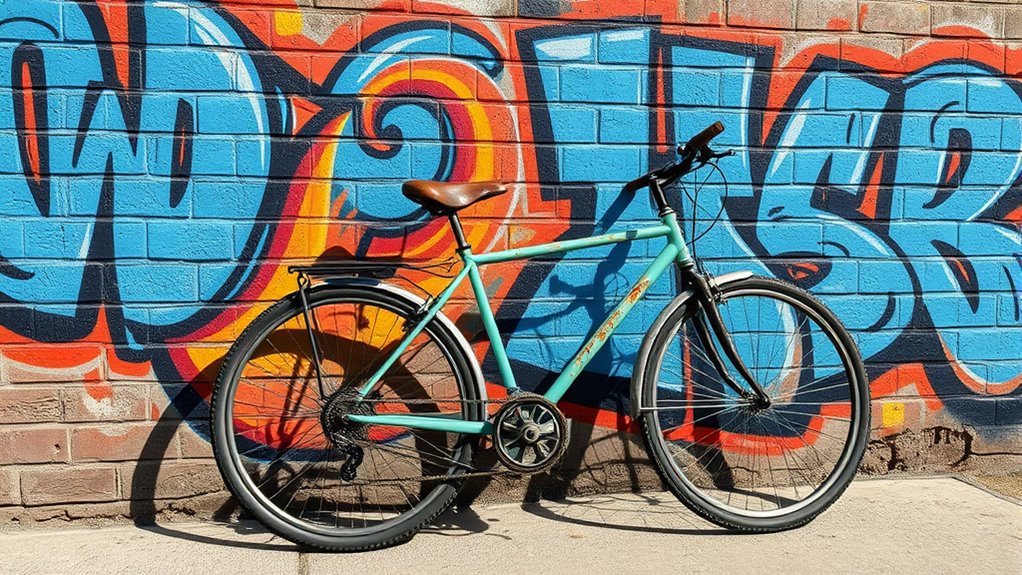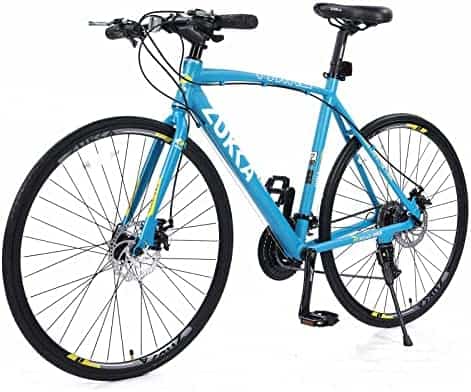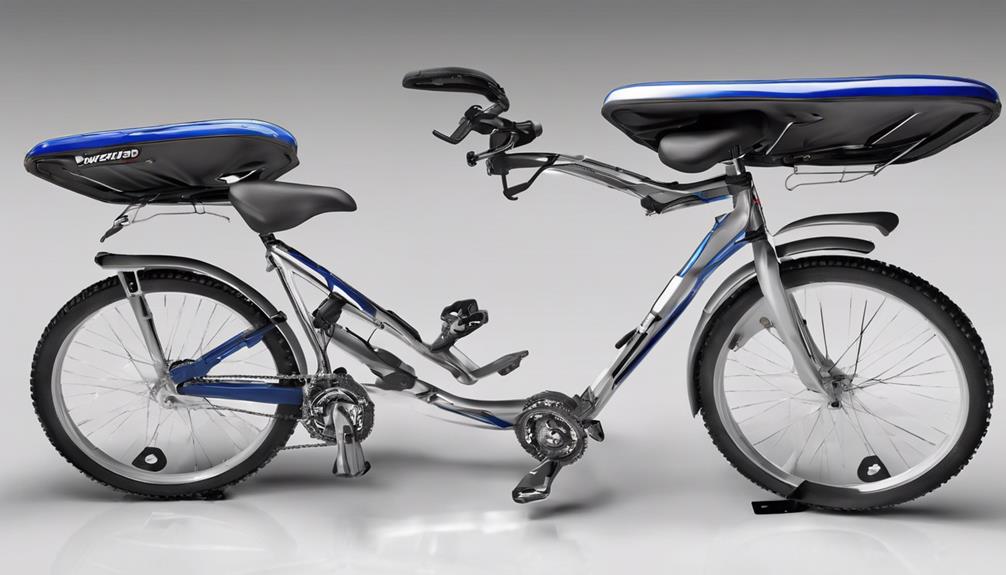Bicycles in street art and graffiti symbolize mobility, social change, and urban pride. They highlight themes like gender equality, community, and environmental awareness while reflecting local culture and history. Artists use vibrant techniques, recycled parts, and mixed media to create impactful murals that enhance cityscapes. These artworks foster civic engagement, promote cycling advocacy, and shape urban identity. To uncover how bicycle graffiti continues to evolve and influence city life, explore more about this dynamic art form.
Key Takeaways
- Bicycles symbolize mobility, freedom, and social progress, making them powerful motifs in street art and graffiti.
- Bicycle imagery in street art reflects urban identity, community engagement, and cultural values of cities worldwide.
- Artists utilize techniques like spray paint, stenciling, and mixed media to depict bicycles, enhancing visual storytelling.
- Bicycle murals often advocate for cycling infrastructure, environmental awareness, and social equality within urban spaces.
- Technological innovations such as AR and projection mapping are expanding the artistic and interactive potential of bicycle-themed street art.
The Symbolic Significance of Bicycles in Urban Art
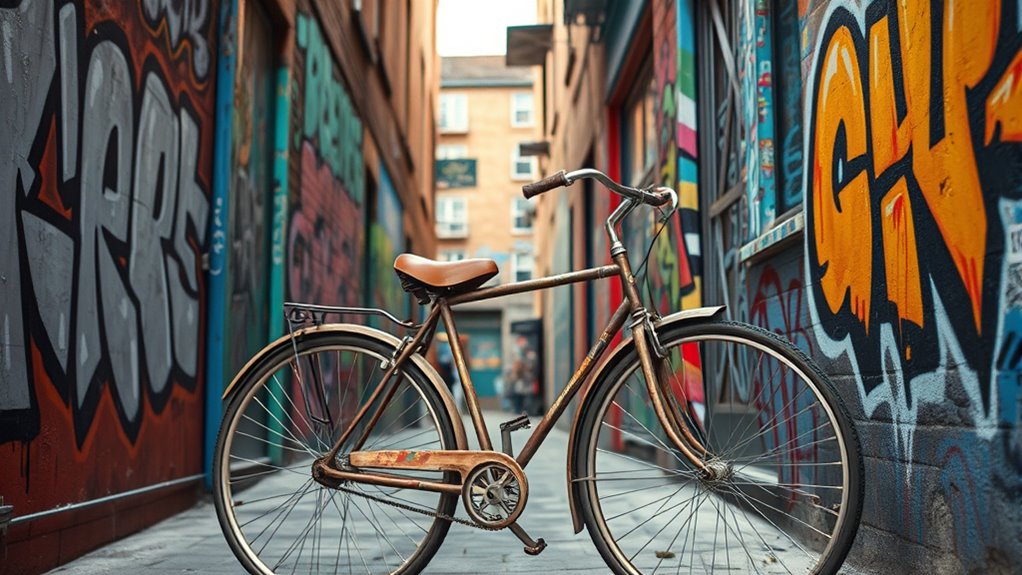
Bicycles have long served as powerful symbols in urban street art, representing more than just transportation. Historically, they symbolize mobility—physical and social—especially for women seeking freedom in the late 19th century. Early films like *Hyde Park Bicycling Scene* captured bicycles as icons of gender equality and modern urban life. The color accuracy of bicycles in art can also reflect cultural values and technological advancements over time. Over time, their symbolism reflects socioeconomic divides, with ownership denoting class status. Bicycles also evoke utopian ideals, linking cycling to social reform and progress. Modern art often uses bicycles to critique consumerism, highlight urban vitality, and symbolize societal progress. Visual symbolism of bicycles continues to evolve, emphasizing their role as catalysts for community engagement and social activism. They serve as visual metaphors for renewal, movement, and community identity. As a versatile symbol, bicycles in street art challenge norms and inspire dialogue on social change and collective mobility. Additionally, the cultural significance of bicycles can mirror shifts in societal attitudes and values over different eras. Incorporating cultural intelligence into urban art initiatives can foster greater community understanding and participation. Furthermore, the historical context of bicycles highlights their importance in shaping modern transportation and social narratives.
Popular Locations for Bicycle-Inspired Graffiti
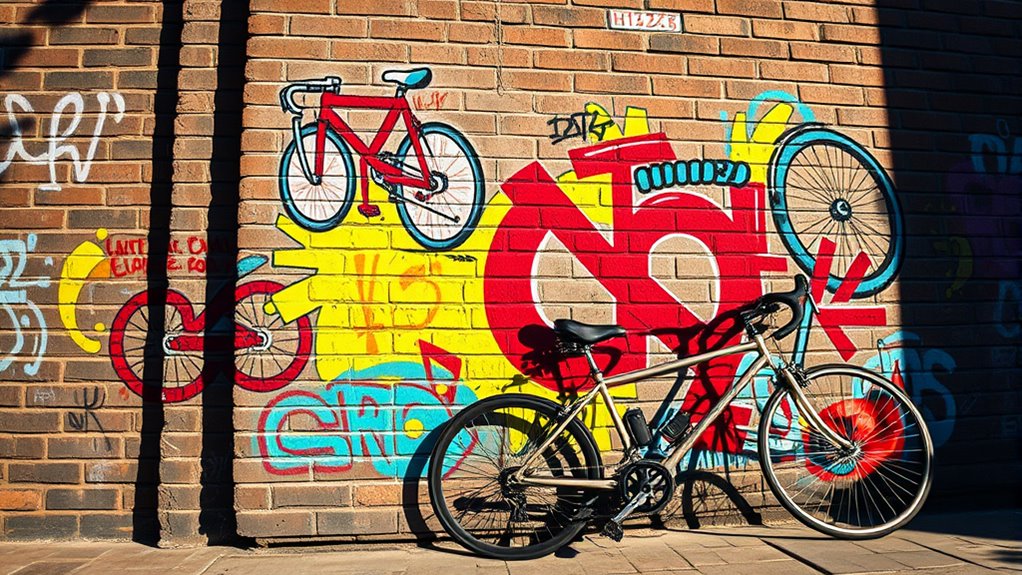
Cities around the world have become vibrant canvases for bicycle-inspired graffiti, turning urban spaces into open-air galleries that celebrate cycling culture. In Barcelona, the Park of the Three Chimneys serves as a hub for street artists and graffiti enthusiasts, fostering a creative environment that encourages urban expression.
Cities worldwide embrace bicycle-inspired graffiti, transforming urban spaces into vibrant open-air galleries celebrating cycling culture.
New York City’s Brooklyn neighborhood hosts popular graffiti bike tours, showcasing diverse street art scenes and murals. These tours often highlight the importance of urban mobility in shaping vibrant city landscapes and community interactions. The integration of public art spaces further enhances the accessibility and visibility of these artworks, making street art a key component of urban culture. Additionally, these initiatives can positively influence community engagement, encouraging residents to participate in local arts and sustainable transportation efforts. Incorporating innovative transportation methods like bicycles can also promote environmentally friendly urban development and reduce traffic congestion.
Chicago’s Logan Square area features notable tours focused on local graffiti and hip-hop history, emphasizing the cultural significance of street art in urban development.
Meanwhile, Valparaiso in Chile is recognized for its rich murals and creative expressions, often highlighting urban mobility themes.
These locations attract both artists and visitors, transforming city streets into lively exhibitions. Guided bike tours and festivals further amplify the vibrant connection between cycling and street art, making these sites essential to urban graffiti culture. Cost and Budgeting considerations can influence the accessibility and development of these art spaces, ensuring sustainable and inclusive urban environments.
Artistic Techniques and Materials Used in Bike-themed Murals

Street artists harness a variety of techniques and materials to bring bike-themed murals to life, transforming urban walls into dynamic visual stories. Spray paint is the primary medium for creating large, vibrant images, with stenciling used to precisely replicate bike parts like gears and chains. Layering techniques add depth, overlapping silhouettes or creating motion effects, while aerosol gradients mimic metallic textures for vintage bikes. Quick-drying spray paints enable rapid outdoor execution. Additionally, incorporating rustic decor elements and earthy tones can enhance the authentic, farmhouse-inspired aesthetic of the artwork. Artists also incorporate mixed media, such as acrylic or oil paints for detailed vintage components, metallic leafing to highlight chrome, and collage elements made from recycled bike parts. Protective sealants shield murals from weather, and digital transfers preserve design authenticity. Exploring artistic techniques beyond spray paint, some artists utilize projection mapping for precise outlines, elevating the complexity of bike-inspired murals. These techniques combine to craft striking, durable bike-inspired street art, and understanding aerosol application methods can further improve the quality and longevity of murals.
The Influence of Bicycle Art on Cycling Culture and Advocacy
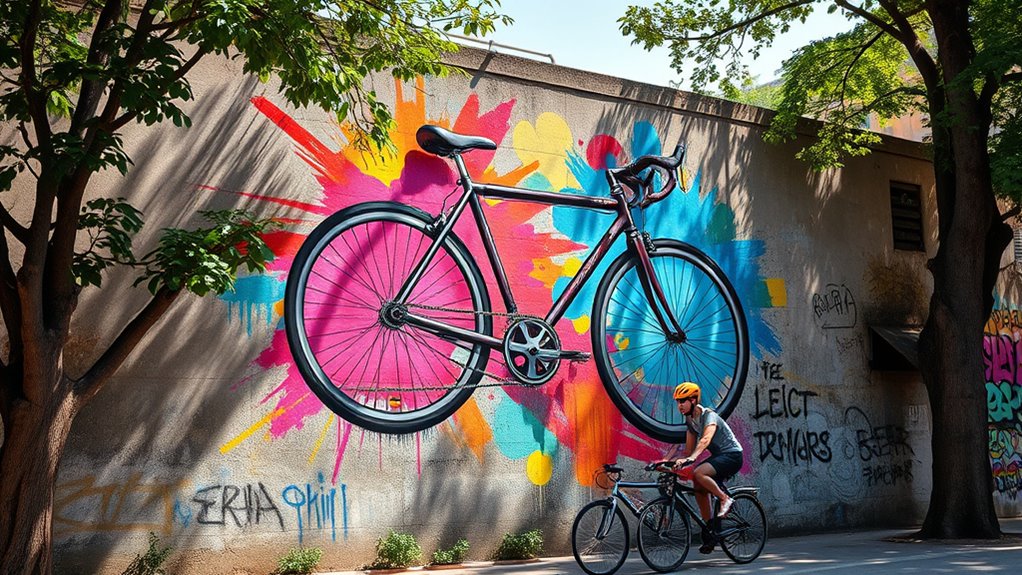
Bicycle art has become a powerful tool for shaping cycling culture and advocating for change. It promotes eco-conscious messages, encouraging people to see cycling as a low-carbon transportation option. Public installations using recycled bike parts raise environmental awareness, while collaborations connect cycling themes to urban green initiatives. By utilizing segmentation techniques, artists and advocates can target specific communities to maximize impact and engagement. Artists like Ai Weiwei incorporate bikes in large-scale works that comment on mass production and consumption. Cycling advocacy groups use street art to visualize reduced car reliance, inspiring communities. Neighborhood bike festivals foster local engagement, and youth programs teach bike maintenance alongside mural painting. Guerrilla art reclaims public spaces, and memorial installations honor fallen cyclists. Additionally, incorporating curiosity about cycling benefits can motivate more people to participate in these initiatives. Moreover, integrating educational messages about cycling health advantages further enhances community support and participation. Understanding the impact of public art on community attitudes can significantly boost the effectiveness of these campaigns. Overall, bike-themed street art strengthens cycling identity, promotes infrastructure development, and amplifies advocacy efforts, making streets more bike-friendly.
Preservation Challenges Facing Bicycle Street Art
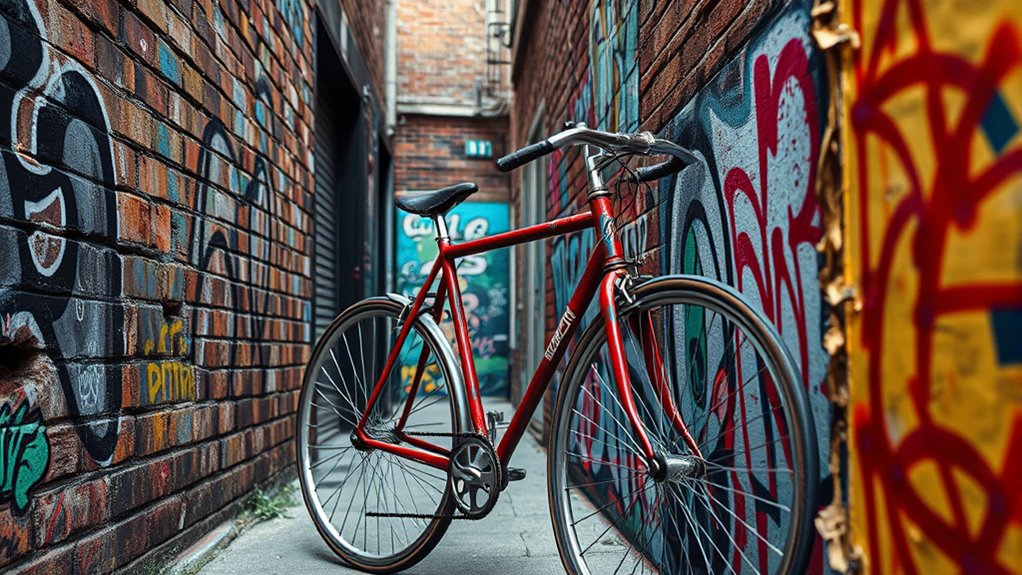
Preserving bicycle street art faces a range of challenges that threaten its longevity and integrity. Environmental factors like rain, wind, UV radiation, pollution, and temperature swings cause paint to fade, crack, or peel. Biological growth such as mold or algae can also damage porous surfaces.
Physical threats include vandalism, collateral damage from nearby construction, vehicle collisions, and wear from foot traffic or bicycle parking. Theft of portable installations adds another risk.
Legal issues, like ownership disputes and strict anti-graffiti laws, complicate conservation efforts, while limited funding prevents proper preservation. Techniques like protective coatings or relocating sections risk altering the original work or losing context.
Furthermore, multi-surface artworks require complex approaches, and microclimate variations accelerate deterioration, making preservation a challenging, ongoing process.
Digital Platforms Amplifying Bicycle Graffiti Worldwide
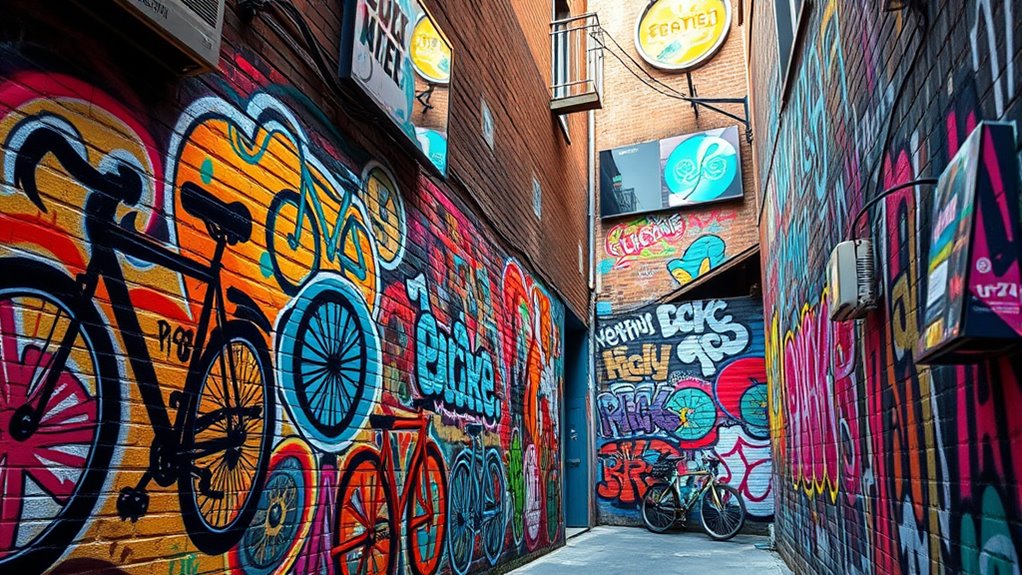
Digital platforms have revolutionized how artists worldwide create, share, and collaborate on bicycle graffiti. Online design tools let you craft detailed digital artwork, achieving precision impossible with spray cans. Projection mapping turns bike frames into animated canvases, while 3D modeling helps visualize graffiti on various bicycle geometries. Augmented reality apps let you preview designs directly on bikes in real environments. Cross-border collaborations thrive through cloud-based networks, enabling artists to co-create in real-time. Digital workshops teach bicycle-specific graffiti techniques remotely, broadening skill access. Shared repositories and social media organize global challenges, fostering innovation. Additionally, hybrid exhibitions combine physical and digital art—projectors, QR codes, and LED displays showcase graffiti in urban spaces. The integration of digital painting techniques allows for even more detailed and vibrant designs to be applied virtually before executing them physically. These platforms amplify your creative reach and connect you with a worldwide community. Moreover, virtual collaboration enables artists to exchange ideas and feedback instantly, enhancing the overall quality of bicycle graffiti projects. Furthermore, leveraging digital tools can streamline the creative process, making complex designs more accessible to artists at all skill levels. By utilizing cloud-based platforms, artists can easily archive and showcase their work, gaining broader exposure and recognition. Incorporating digital skill development ensures artists stay updated with the latest technological advancements in street art.
Community Engagement Through Bicycle-Themed Street Art
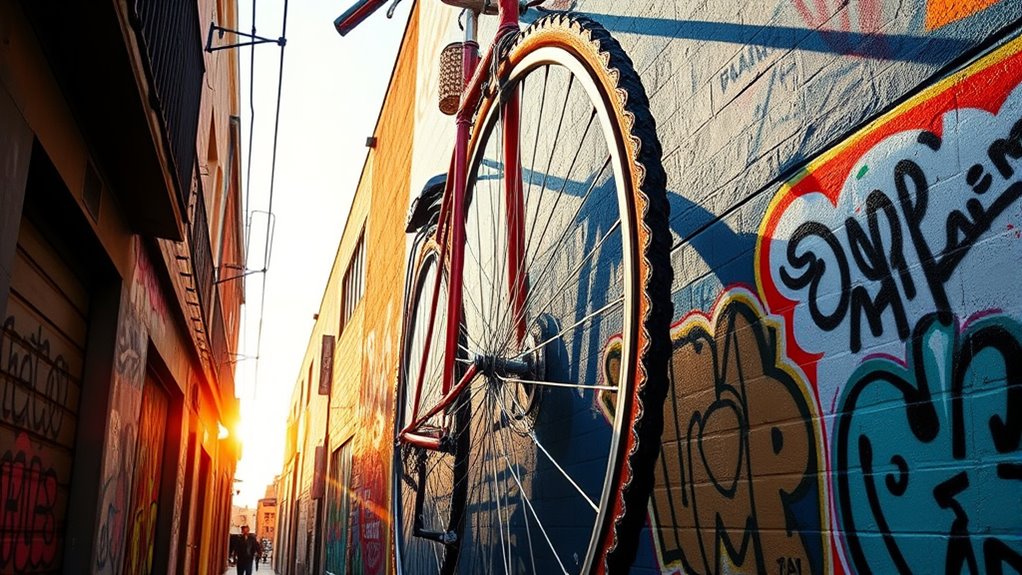
Community engagement through street art creates a powerful connection between residents and their urban environment, transforming public spaces into vibrant hubs of interaction. You can participate in public art installations that feature bicycles, encouraging hands-on involvement through interactive displays and sculptures.
Community workshops invite you to co-design bike-themed projects, fostering collaboration among residents. These initiatives emphasize shared spaces, bringing cyclists and pedestrians together to improve accessibility and safety.
Bicycle-themed street art often incorporates educational messages about bike safety and urban planning, sparking conversations about city development. By engaging in these projects, you help build community pride, reflect local culture, and revitalize neglected areas.
Participatory tours and public dialogues make art accessible, creating a sense of ownership and inspiring collective efforts toward creating more inclusive, lively urban environments.
The Impact of Bicycle Murals on Urban Identity and Pride
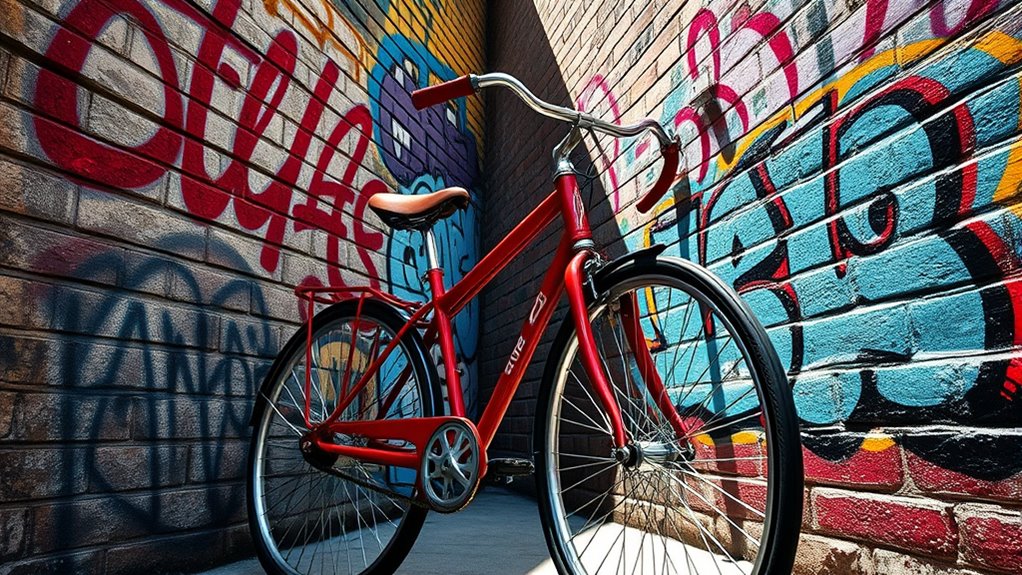
Have you ever noticed how vibrant bicycle murals can redefine a neighborhood’s identity? These murals serve as powerful symbols of movement, energy, and urban vitality, transforming plain walls into landmarks of pride.
Vibrant bicycle murals transform neighborhoods into lively symbols of movement and community pride.
When artists depict bicycles, they highlight sustainable mobility and environmental awareness, linking cycling culture to community values. Murals often reflect local histories, capturing collective memories and fostering a sense of belonging.
They also counteract visual monotony, turning blank surfaces into eye-catching conversation starters. By boosting street appeal, bicycle murals attract visitors and support local businesses, increasing neighborhood pride.
They create a shared sense of ownership and civic engagement, reinforcing cycling as a lifestyle choice. Overall, these artworks strengthen urban identity, making communities feel more connected and proud of their unique cultural fabric.
Future Trends in Bicycle-Inspired Urban Art
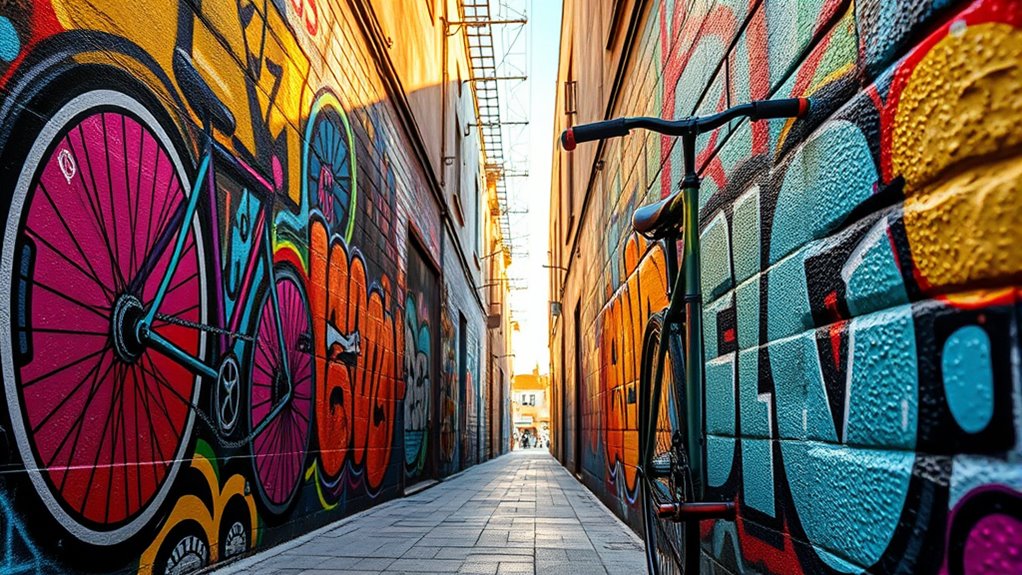
Advancements in technology and innovative materials are rapidly transforming bicycle-inspired urban art, opening new possibilities for creative expression and public engagement. You’ll see reflective paints and LED-integrated components that boost visibility and interactivity in cityscapes.
Augmented reality overlays allow viewers to experience dynamic, layered artworks through smartphones or AR glasses, making art more immersive.
Sustainability influences artists to reuse bicycle parts and eco-friendly paints, aligning art with environmental values.
Techniques like 3D printing enable complex sculptures, while sensors add responsive elements that react to light or sound.
Community-driven projects, such as murals and pop-up exhibits, foster local participation and promote cycling culture.
Meanwhile, futuristic bicycle designs inspire innovative visual storytelling, blending technology with urban aesthetics and pushing street art into new, exciting directions.
Frequently Asked Questions
How Do Artists Legally Obtain Permission for Bicycle Murals in Public Spaces?
To legally get permission for bicycle murals in public spaces, you need to start by identifying the property owner or relevant city department.
You should then apply for permits, which often involve submitting project details, insurance, and community support.
Engage with local authorities early, follow regulations, and obtain necessary approvals.
Building community backing can also help smooth the approval process and guarantee your mural aligns with local standards.
What Are the Environmental Impacts of Creating and Maintaining Bike Graffiti Murals?
You might find that creating bike graffiti murals whispers about environmental impacts. Using paints and materials can unintentionally cause pollution if not disposed of carefully.
Frequent repainting and cleanup efforts consume energy and resources, possibly increasing emissions. However, opting for eco-friendly paints and involving the community in maintenance can soften these effects.
This approach not only reduces environmental harm but also promotes awareness and responsibility through vibrant, sustainable urban art.
How Do Digital Tools Influence the Design Process of Bike-Themed Street Art?
Digital tools greatly influence your design process by allowing precise mapping and scalable artwork that fits urban spaces perfectly. You can validate routes, avoid obstacles, and customize your bike art with ease.
Collaboration platforms enable remote teamwork, while GPS files ensure your designs are executable in real-world rides. These technologies streamline your workflow, enhance creativity, and help you adapt your street art projects efficiently to different environments and community needs.
Are There Specific Safety Considerations for Artists Working on Large Outdoor Murals?
You might think painting outdoors is just about creativity, but safety’s a sneaky villain. You need weather-resistant paints and regular inspections to prevent fading or damage.
Use PPE like respirators, gloves, and goggles to dodge toxic fumes and splashes. Secure scaffolding, check ladder stability, and wear high-visibility vests.
And don’t forget to keep the site ventilated and restrict access during hazardous tasks—art’s safe, after all, isn’t it?
How Does Bicycle Graffiti Influence Urban Policy and Transportation Planning?
Bicycle graffiti influences urban policy by highlighting community issues and pushing for inclusive transportation planning.
When you see graffiti calling for safer, protected bike lanes, it raises awareness and pressures policymakers to prioritize equitable infrastructure.
Your support for these messages can amplify grassroots movements, encouraging city officials to address disparities, improve safety, and foster diverse, accessible cycling networks that serve all residents, not just privileged groups.
Conclusion
You might think bicycle-inspired street art is just visually appealing, but it actually symbolizes freedom, progress, and community spirit. Some believe it even fosters greater cycling advocacy by inspiring city residents to embrace active transportation. As digital platforms showcase these murals worldwide, their influence grows, strengthening urban identity. Embracing this art form not only beautifies neighborhoods but also fuels conversations about sustainable mobility—proving that bicycles and street art together can truly transform city life.
